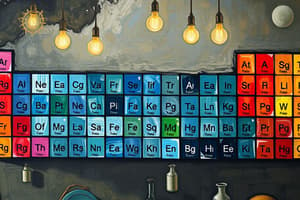Podcast
Questions and Answers
What is the basis of the modern periodic table?
What is the basis of the modern periodic table?
What type of reaction results in the exchange of atoms or radicals between two reactants?
What type of reaction results in the exchange of atoms or radicals between two reactants?
What is the trend of atomic size in a period?
What is the trend of atomic size in a period?
What is the effect of moving from left to right in a period on the chemical reactivity of metals?
What is the effect of moving from left to right in a period on the chemical reactivity of metals?
Signup and view all the answers
Who developed the periodic table based on atomic weight?
Who developed the periodic table based on atomic weight?
Signup and view all the answers
What is the product of an acid-base reaction?
What is the product of an acid-base reaction?
Signup and view all the answers
What factors affect the rate of chemical reactions?
What factors affect the rate of chemical reactions?
Signup and view all the answers
What is the purpose of studying the electronic configurations of elements?
What is the purpose of studying the electronic configurations of elements?
Signup and view all the answers
What is the general trend of chemical reactivity of metals in a group?
What is the general trend of chemical reactivity of metals in a group?
Signup and view all the answers
What is the significance of the periodic table in studying element properties?
What is the significance of the periodic table in studying element properties?
Signup and view all the answers
What is the role of catalysts in chemical reactions?
What is the role of catalysts in chemical reactions?
Signup and view all the answers
What is the limitation of Mendeleev's initial classification of elements?
What is the limitation of Mendeleev's initial classification of elements?
Signup and view all the answers
What is the expected outcome of further research on the electronic configurations of elements?
What is the expected outcome of further research on the electronic configurations of elements?
Signup and view all the answers
What is the significance of understanding the trends in valency, atomic size, electropositivity, electronegativity, and chemical reactivity of elements?
What is the significance of understanding the trends in valency, atomic size, electropositivity, electronegativity, and chemical reactivity of elements?
Signup and view all the answers
What is the general trend of nonmetals in a group?
What is the general trend of nonmetals in a group?
Signup and view all the answers
What is the significance of temperature and pressure in chemical reactions?
What is the significance of temperature and pressure in chemical reactions?
Signup and view all the answers
Study Notes
Classification of Elements
- Elements are classified into metals, nonmetals, and metalloids based on their properties.
- Atomic number is the basis for organizing elements in the modern periodic table.
Development of the Periodic Table
- Dmitri Mendeleev created the periodic table based on atomic weight, but later refined by Henry Moseley to be based on atomic number.
- The modern periodic table is organized by atomic number, with metals on the left, nonmetals on the right, and metalloids in between.
Electronic Configuration
- Elements' electronic configurations are based on shells and subshells.
- Understanding electronic configurations helps in explaining the properties and behavior of elements.
Chemical Reactions
- Double displacement reactions result in the exchange of atoms or radicals between two reactants.
- Acid-base reactions form salt and water through the reaction of an acid and a base.
- The rate of chemical reactions varies, with factors like temperature, pressure, and catalysts affecting the reaction speed.
Objectives and Methods
- Objectives include understanding displacement reactions, conducting experiments, exploring the rate of reactions, and studying the effects of catalysts.
- Methods involve studying properties of elements, preparing a periodic table, and analyzing electronic configurations.
Results
- The modern periodic table is based on atomic number.
- Atomic size decreases from left to right in a period.
- Chemical reactivity of metals decreases along a period, while nonmetals increase.
- Chemical reactivity of metals increases from top to bottom of a group, and nonmetals decrease.
- Displacement and double displacement reactions form new compounds.
- Acid-base reactions involve neutralization.
- Catalysts impact reaction rates.
Trends in the Periodic Table
- Valency, atomic size, electropositivity, electronegativity, and chemical reactivity exhibit specific trends within the periodic table.
- Trends influence the properties and behavior of elements.
Conclusion and Limitations
- The properties of elements are determined by their group and period in the periodic table.
- Temperature and pressure affect reaction rates, and catalysts alter reaction speeds.
- Limitations include the initial classification of elements based on atomic weight, and the need for further research on electronic configurations and metalloids.
Studying That Suits You
Use AI to generate personalized quizzes and flashcards to suit your learning preferences.
Description
Learn about the classification of elements into metals, nonmetals, and metalloids, and the development of the periodic table by Dmitri Mendeleev and Henry Moseley.




